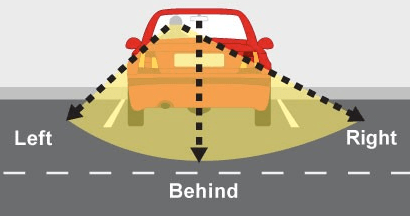Backing Your Vehicle Is Always Dangerous to Do
Backing up Safely

Backing up Safely | Comedy Traffic School .COM
Many fender-benders occur when drivers back up. Since the risks are higher for collisions while backing, take special care to make sure you don't back-up without visually clearing the area behind the vehicle first. Many times each year, children are run over in their own driveways because drivers didn't look behind their vehicles first. For this reason, many companies require their drivers to place an orange traffic cone behind their vehicles when they park, forcing them to look behind it again as they pick up the cone prior to driving away.
Once you've cleared the area behind you, turn and look to the rear while you back. In trucks, you may not be able to see directly to the rear, except in the side view mirrors. It's always a good idea to have a "spotter" behind you in these circumstances, a second person standing behind your vehicle where you can see them, giving you information about how you are doing. Keep your speed very low—down to a crawl.
There are a couple more ways to protect against parking lot mishaps. If you can, pick a parking spot you can pull straight into and on to the next row, so that when you depart, you are pulling forward out of your spot instead of backing up. In busier parking lots where this is not possible, try backing into your parking space to begin with instead of backing out when you leave. The advantage is you can visually clear the parking spot as you approach it, adding a bit of extra safety, and then exit it forward instead of backing into the driving lane as you leave.
It's not easy to be safe when trying to back up on a roadway you're sharing with many other vehicles and pedestrians. One situation where you shouldn't back up is when you overrun a "stop line" at an intersection while stopping for a red light (or stop sign). If this happens, and you find yourself straddling the crosswalk, it is usually better to stay where you are, rather than backing up to the proper place. Backing up through a crosswalk can be much more dangerous for obvious reasons.
Another exception is on controlled access highways, where it is illegal to stop or back up anywhere on the right-of-way, including shoulders, gore areas, off-ramps and access roads.
To summarize:
Always back up slowly to avoid collisions. It is always dangerous because it is hard to see what is behind your vehicle. Whenever you need to back up or back out of a parking space, follow these rules:
- Turn and look over your right shoulder when backing out the vehicle. Do not depend only using your mirrors.
- Before getting in a vehicle, a driver should always check behind the car. Children, pets, and small objects are hard to see from the driver's seat.
- A driver should make sure that it is legal to back up. It is not legal on the freeway.
- A driver should check traffic in both directions.
- Drivers should release the parking brake and look over their inside shoulder with their left hand on the steering wheel. They should then release the foot brake slowly. Drivers should apply the accelerator if needed and be ready to brake to control the speed of the car. They should then proceed slowly.
- A driver should check the front occasionally if backing up takes more than a few seconds.
- Backing around a corner is always a dangerous maneuver. A driver should go slowly and stop until he or she gets a clear view of any traffic, pedestrians, or other objects in the way.
- If, as a driver, you notice movement is constricted when attempting to back up, ask a passenger or someone to help you get out of the spot. Look through the rearview and side-view mirrors before attempting to back up.
- Since so many collisions occur while backing up, try not to back up if possible. Rather, look for a parking space that does not require backing up. Try to park in a relatively traffic free area; often, it is possible to drive forward instead of backing up.
Backing Your Vehicle Is Always Dangerous to Do
Source: https://www.comedytrafficschool.com/backing-up-safely/
0 Response to "Backing Your Vehicle Is Always Dangerous to Do"
Post a Comment